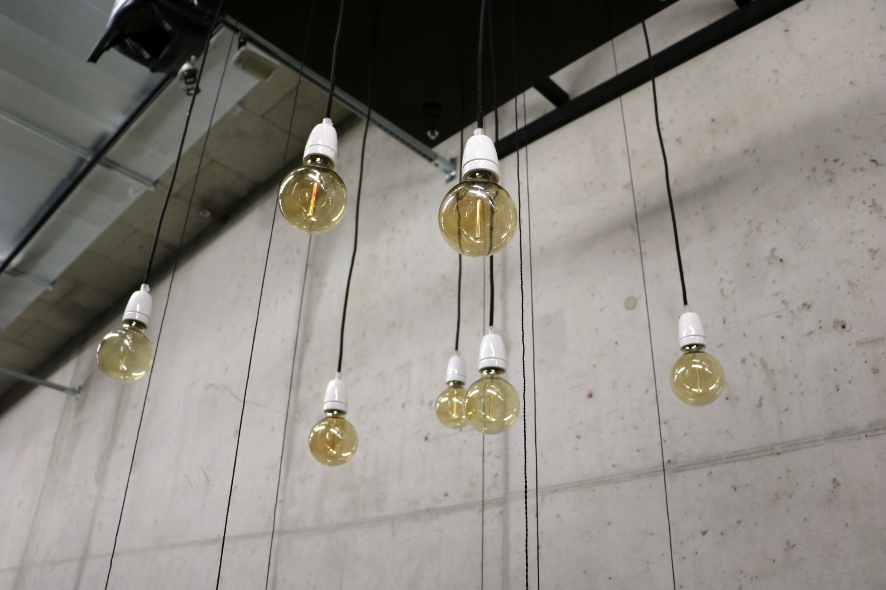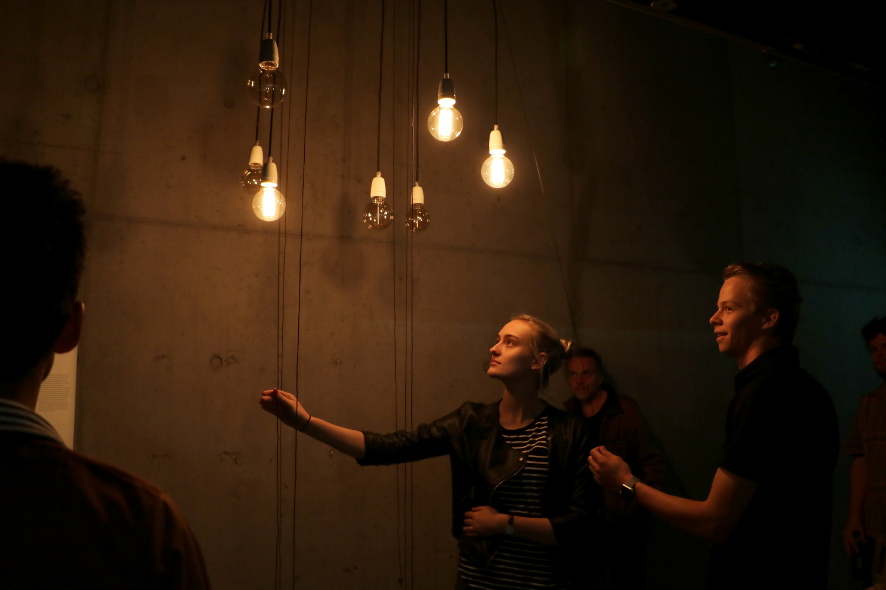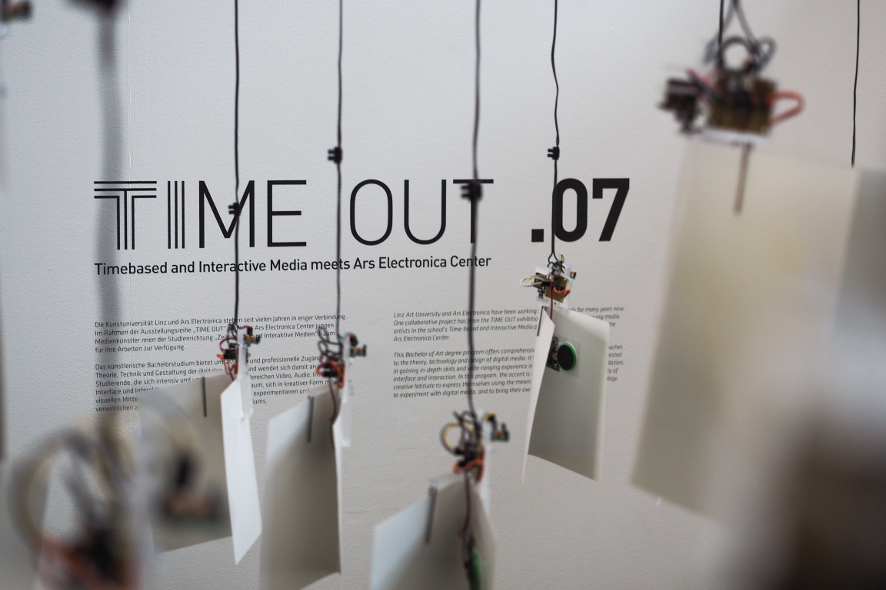This is Round 7 of TIME OUT, an exhibition series offering visitors to the Ars Electronica Center insightful looks at work being done by undergraduates in the Time-based and Interactive Media program at Linz Art University. The arts bachelor program offers students the latitude to express themselves creatively in audiovisual terms, to experiment with digital media, and to implement their own ideas. This show was once again curated by Gerhard Funk, the director of the program, and Gerfried Stocker, artistic director of Ars Electronica. They selected nine students whose works are being presented in the Ars Electronica Center.
In Lisa Bickel’s work “Heimkommen” (Coming Home), she poses a series of questions: What do you hear when, after a long day, you come home and switch on the light? How is the atmosphere? Which sound do you perceive as pleasant? What is annoying? Suspended from the ceiling of her installation are light bulbs that visitors can turn on and off at will. When the light bulbs are switched on, they emit common, everyday sounds and noises designed to arouse the feeling of being at home. We asked Lisa to tell us about her work.

Lisa Bickel’s installation “Heimkommen” (Coming Home) during exhibition set-up. Credit: Magdalena Sick-Leitner
Please explain to us how your installation works. What can visitors do?
Lisa Bickel: “Coming Home” endeavors to shift installation visitors from an unfamiliar situation in a museum into familiar circumstances. You come home and turn on the light. The act of switching the light bulbs on and off generates individual soundscapes reminiscent of home. Sounds you hear on a daily basis but often don’t even notice engender a feeling of intimacy and evoke memories.
What made you want to deal with the subject of coming home?
Lisa Bickel: During the time I was developing this project, the influx of refugees was a very relevant and much-discussed issue that strongly influenced me and led me to give some thought to “homeland” and “having a home.” What does it mean to have a home? Where does one feel at home? Can one feel at home somewhere else? What triggers this feeling? These are questions that don’t just affect refugees; this is a matter for every human being.

Visitors interact with Lisa Bickel’s installation “Coming Home”. Credit: Magdalena Sick-Leitner
You could also have, for instance, emphasized the smells you become aware of when you come home. What meaning do these particular sounds have for you?
Lisa Bickel: Since I work a lot in the medium of film, I’ve come to realize the powerful significance of sound. I’ve always been fascinated by how certain sounds can evoke emotions and memories. In this project, I experiment with whether such feelings can be aroused strictly on the auditory level.
When you come home, do you like peace and quiet or do you prefer to be surrounded by sounds? Do you have a favorite sound?
Lisa Bickel: I believe that total silence at home is impossible. There are always noises that we don’t even perceive because we’re so accustomed to them—for example, sounds from out on the street; the ticking of the clock; the birds chirping; the hum of a lamp. l live together with a roommate, and I like it when things are happening in our apartment, when it sounds lively. My favorite sound? … Maybe, when my roommate says “Dinner’s ready!” :-)

Clemens Niel’s interactive installation “Greetings” can be seen in Foyer Gallery of the Ars Electronica Center. Credit: Martin Hieslmair
Suspended from the ceiling in Clemens Niel’s installation “Greetings” are greeting cards with integrated sound modules, which usually play melodies or best wishes for some occasion. In Niel’s work, these cards are opened and closed by tiny control units whenever a visitor enters the installation space. But instead of the familiar melodies, they emit background noise from the factory and test remarks spoken by the factory workers during the process of manufacturing the sound modules. We sat down for a chat with Clemens.
The setup of your installation looks highly technical and sounds that way too. Could you please go into a bit of detail about this?
Clemens Niel: “Greetings” is an interactive spatial installation consisting of 45 autonomous, almost identical machines, each of which opens and closes a greeting card containing a sound module. Each machine is equipped with an infrared sensor that, as soon as it registers motion in the installation space, sends a signal to a servomotor, which opens the greeting card. That, in turn, completes the electrical circuit of the card’s sound module, which plays back the sound file stored to memory on it.
Your installation deals with the meta-theme “work”—manufacturing processes, the expenditure of labor, estrangement from work. How did you come upon this topic?
Clemens Niel: Employment relationships as well as the visible and invisible structures that arise from them are, in my opinion, a defining characteristic of a society. With my work, I’m trying to put forth some abstract food for thought in this direction in order to get people to critically question these relationships and structures.
Why did you choose such an unprepossessing product as a greeting card to serve as the medium for your considerations of the subject of work?
Clemens Niel: This was an intuitive decision, but in retrospect I find the contrast between the delicate cards and the industrial mass production of the electrical components used in them to be very fitting.
This isn’t your first media art project. What do you plan to do next?
Clemens Niel: I’m now working on a series of installations entailing interactive objects that, by means of short automated movements, deprive devices of their actual function and modify them into aesthetic objects.

Servomotors will open and close greeting cards. As in this picture during set-up still without the cards. Credit: Magdalena Sick-Leitner
The TIME OUT .07 exhibition opened on May 23, 2017. Visitors can view these works by student at any time during the museum’s opening hours.
